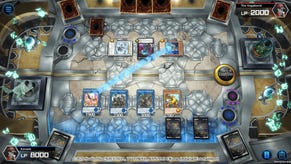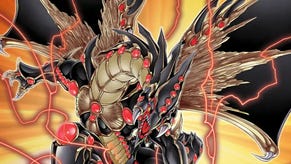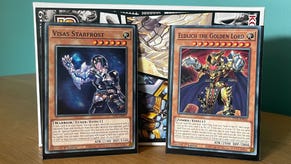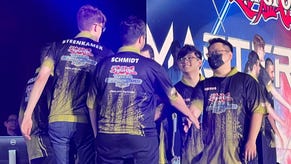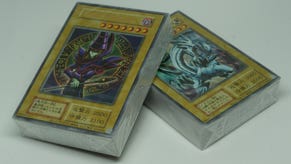How Yu-Gi-Oh! took its iconic Egyptian God cards from their legendary anime appearance to the TCG
A decades-long journey via limited availability, counterfeits and tournament absence.
The Egyptian God cards of Yu-Gi-Oh! were always more than just mere monsters. In the manga and anime they’re introduced as pariahs of glory and ruin, designed by Maximillion Pegasus based on ancient Egyptian deities visible on an old stone tablet.
Slifer the Sky Dragon, Obelisk the Tormentor and The Winged Dragon of Ra were so powerful that their use could injure or kill duelists involved in battles involving the cards. The story of these monsters sits at the core of the iconic Battle City arc of the original manga and anime as a mere city-wide tournament becomes the scene for a duel deciding the fate of the world itself.
In other words, they were the coolest things ever to any pre-teen kid falling in love with the franchise in the early 2000s.
Since those days, these three creatures of divinity have cast their shadow over both fictional and physical incarnations of the Yu-Gi-Oh! card game. Their existence was key to the story of the original anime and manga until their conclusion, and their legacy continued into future incarnations of the franchise like Yu-Gi-Oh! GX.
Their all-powerful nature in these series made them highly-sought yet hard-to-find collectibles, becoming the subject of heavy bootlegging and holding iconic status by anyone with even a passing love for the franchise.
In the original Yu-Gi-Oh! anime, the introduction of the Egyptian God cards in the Battle City arc is shrouded in mystery, kicking off a months-long anticipatory build-up that only truly pays off once we reach the finals of this legendary tournament.
A monster’s origin had never been so important to the series story prior to the introduction of the Egyptian Gods. We may find some heartwarming solace in Yugi’s original deck being a hand-me-down from his Grandfather that saves his soul during Duelist Kingdom, but we aren’t all that interested in how Dark Magician came into existence at this time or why his Grandpa had the card. This was a card game, created by Duelist Kingdom’s mastermind Pegasus, and that was all that really mattered.
Their all-powerful nature in these series made them highly-sought yet hard-to-find collectibles.
This changed things. There’s mystery to the quaint museum visited by Kaiba on invitation from Ishtar, as she reveals a stone tablet of an ancient Kaiba and Yugi dueling with the Egyptian God cards looming beyond. It’s a revelation that brings more questions than answers. What does it all mean? At this point Kaiba receives Obelisk the Tormentor as a gift from the mysterious woman who invited him to this museum, encouraging him to arrange the Battle City tournament with the underhanded goal of bringing these monsters together in one location. Even then, it takes many more episodes before we see any of these cards in action.
Their use in the anime is individual and piecemeal in the lead-up to the finals, their every appearance revealing greater depth and new abilities to their powers. These are cards with a mind of their own who can only truly be wielded by those deemed worthy, deepening a sense of overwhelming awe at their existence.
It all crescendos with the finals of the event, where all three monsters are used in a single duel with the stakes of the world resting on the outcome.
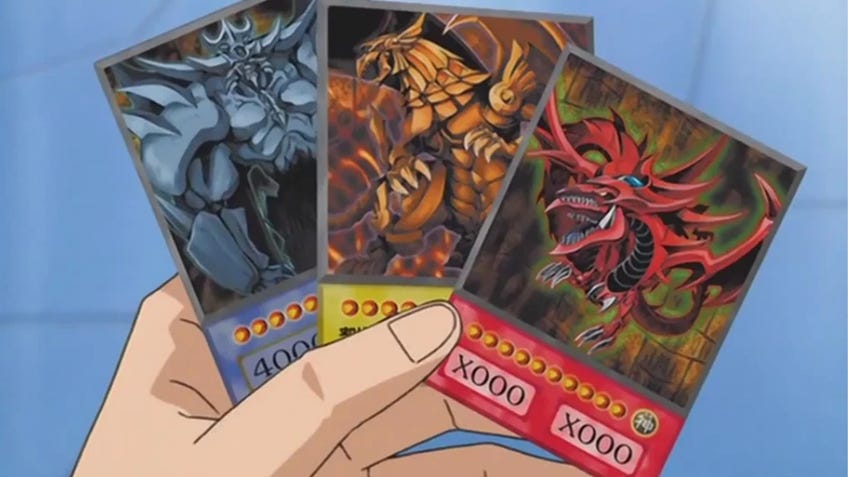
This slow introduction increased anticipation for the Egyptian God cards and cemented their status as titans within Yu-Gi-Oh! that regained the lost allure once offered to Kaiba and Yugi’s signature beasts. We’d seen them enter the fray on enough occasions to diminish their excitement somewhat, even if the love held for these cards by fans remained unchanged. On the other hand, the long-winded introduction and rare subsequent usage allowed them to retain their godlike status and the thrill of their appearance in battle, even before we talk about their crucial plot relevance for the remainder of the series. They say absence makes the heart grow fonder, and that was certainly true here.
This legacy continued even beyond the story of Yugi Moto. In Yu-Gi-Oh! GX they served as the names for dormitories for each class at Duelist Academy and the basis for the Sacred Beast monsters that in turn become key to Jaden Yuki’s story. They’ve been name-dropped in later series, and the beloved nature of these cards means even people who came into the game long after the initial excitement over the original manga and anime had subsided are aware of their status.
Once duelists fell in love with their fictional force, naturally they wanted a piece of it for themselves. Of course, that was easier said than done.
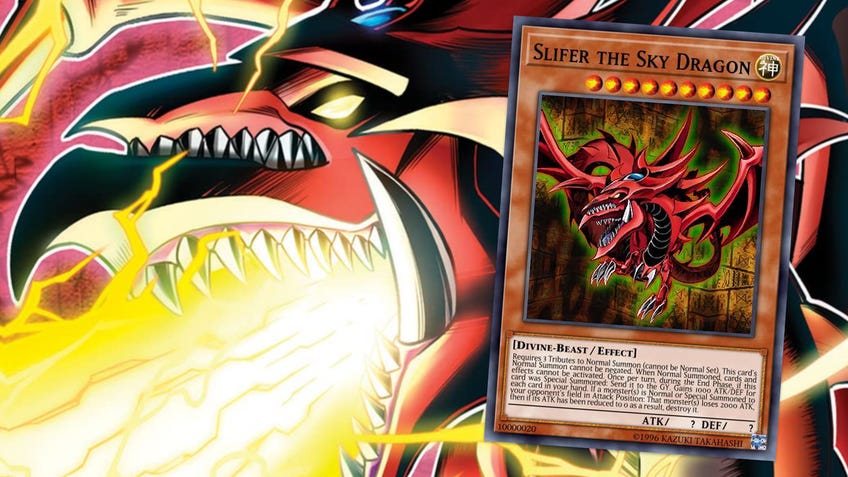
Surprisingly, the first English-language printing of the Egyptian God cards didn’t come from the trading card game itself.
Having been printed in Japanese once before as promo cards for one of the Game Boy Color video games released in 2000, the international release of Yu-Gi-Oh! Worldwide Edition: Stairway to the Destined Duel in 2003 brought English-language printings of the Egyptian God cards to the world for the very first time. Bizarrely, these were still exclusive to the Japanese market - international audiences got one Magnet Warrior, Sinister Serpent and Harpie’s Feather Duster instead. Great cards, sure, but no Egyptian Gods.
The chance of a kid who watched the series having any hope of owning a copy of their own was infinitely slim - so perhaps it was no surprise the counterfeiting scene around these cards was prominent.
These first printings were designed to emulate their appearance in the original series, instantly making these cards stand out as something more than just another monster. The brown colour denoting monster cards was replaced by the red, blue and yellow backing associated with Slifer, Obelisk and Ra respectively. Their attack values retained their anime appearance, too, all the way down to Slifer’s X000 attack power.
They weren’t designed as tournament-legal cards, but a representation of their anime appearance for fans to recreate scenes from the anime through their own memories of their seemingly-infinite power and endless abilities. Players could make things up to retain their indestructibility - which was fine, since these were merely collectibles never designed for legal use in any official capacity.

For collectors around the world, the fact they weren’t even available outside of Japan made no difference; people wanted them, and would do anything to get a hold of them. Even now, cards from this initial printing in their first-run Secret Rare variant are valued in the hundreds, if you can even track one down. The chance of a kid who watched the series having any hope of owning a copy of their own was infinitely slim - so perhaps it was no surprise the counterfeiting scene around these cards was prominent.
Counterfeiting was a rampant problem during the trading card game’s peak as a phenomenon in the early 2000s. This isn’t to say that fake cards looked anything close to the real thing (in many occasions they very much didn’t), but if it allowed a kid to get a hold of an ultra rare beast like the Egyptian God cards they didn’t care. I owned counterfeits alongside my real cards, so did my friends, and I remember seeing more than my fair share of them on childhood holidays on beach stands too.
Unsurprisingly, more than a few kids claimed to have their own God Card only for it to be counterfeit. We didn’t know any better. The art was so cool, the card so alluring; all we wanted was a copy of our own. It’s no wonder you can’t search for examples of counterfeit Yu-Gi-Oh! cards without stumbling on more than a few examples of fake gods.

The first international releases for these cards eventually came in 2004-2005, but even this was highly dependent on your region. First, Ra was released as a promo card with the Xbox Dawn of Destiny game, then Slifer was a promo for the animanga for the first Yu-Gi-Oh! movie, while Obelisk was a promo card in the May 2005 issue of Shonen Jump magazine. Issue is, all of these printings were US-only, with even the European release of Dawn of Destiny replacing Ra with a different promo card, Mesmeric Control.
For all the legendary power they held in fiction, this never translated into tournament victories.
For duelists elsewhere, it took until the first Legendary Collection in 2010 for the cards to be widely available across all TCG regions. By this point the original anime had long-since finished and an entire generation who grew up seeing these cards on screen had faced almost an entire decade with a hole in their childhood collections.
Luckily in the years which followed, the cards remained in regular circulation - albeit rarely in their iconic illegal printing. Starting that same year (once again only in America as Shonen Jump promos) Konami began to release playable versions of these cards, weakening their effects from the anime and manga while retaining their spirit in an attempt to make them playable in tournaments. Slifer’s variable attack power, Obelisk’s monster destruction and Ra’s self-inflicted Life Point damage to destroy monsters were retained in new effects designed within the power constraints of the actual game.
They never gained a competitive edge in this form, but additional support over the years at least made it possible to build a deck around the God Cards. Ancient Chant was designed to somewhat mitigate the crushing Life Point cost of Ra by allowing it to gain additional ATK/DEF from tributed monsters, for example, but it never really overcame the high costs that held the monster back in the first place. For all the legendary power they held in fiction, this never translated into tournament victories.
Ironically, the only time that the Egyptian God cards have seen competitive relevancy came via one of their support monsters. The Winged Dragon of Ra - Sphere Mode is an interesting tech card that has faded in and out of competitive play thanks to its summoning conditions. Players aren’t really bothered that this could be used to bring out the real Ra as a 4000 ATK titan - they care that it can tribute monsters from both sides of the field before being summoned to your opponent’s field as a blockade on their play. It’s not always the best choice, but has occasionally seen some play as a card that can wipe away pesky boss monsters and slow down your opponent’s strategies at crucial moments.
The allure created by Yu-Gi-Oh!’s late creator Kazuki Takahashi around these cards has never waned, even as greater accessibility to the Egyptian Gods removed any mystique they once held. Nowadays, only Dark Magician and Blue-Eyes White Dragon are more recognisable, and they still hold a pedestal of power despite their legal varient’s competitive success. Does nostalgia play a part in this status? Obviously, but it’s so much more than that. True strength is never bestowed upon anything - it is earned.




